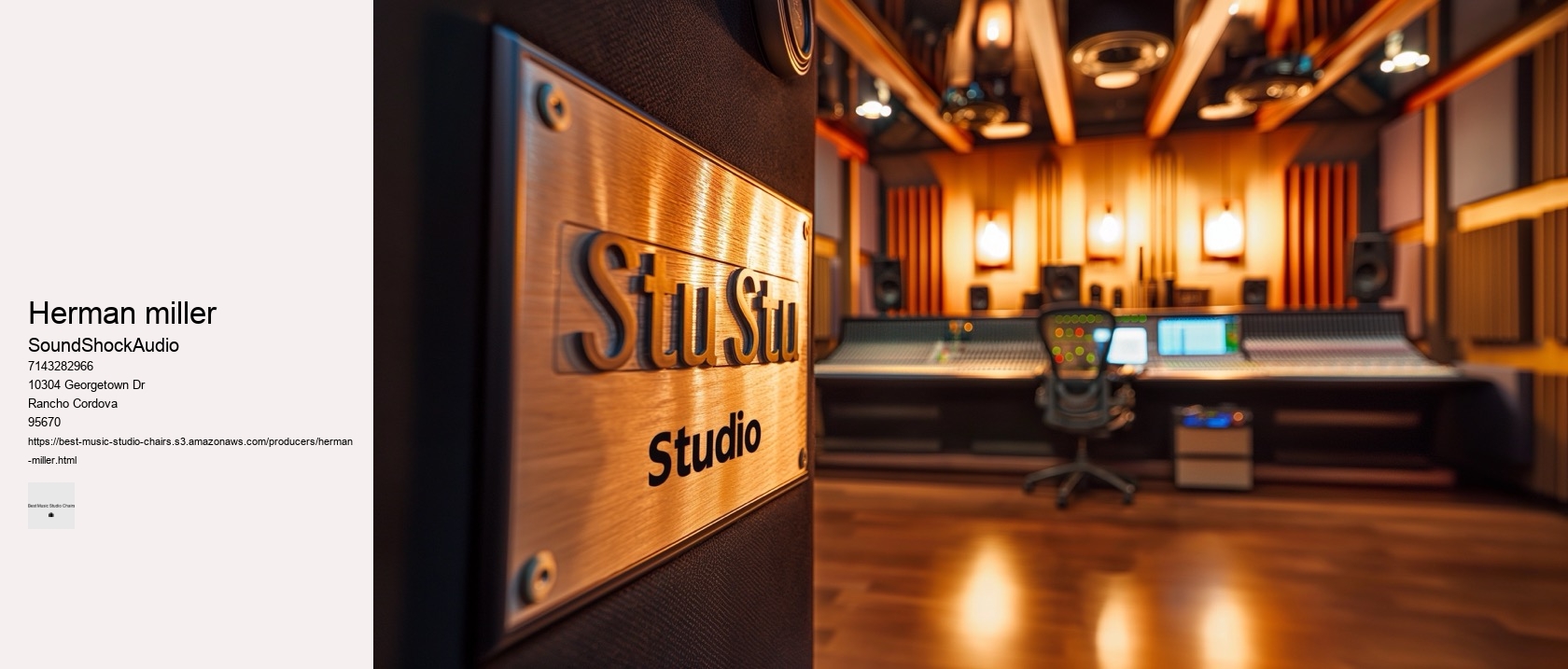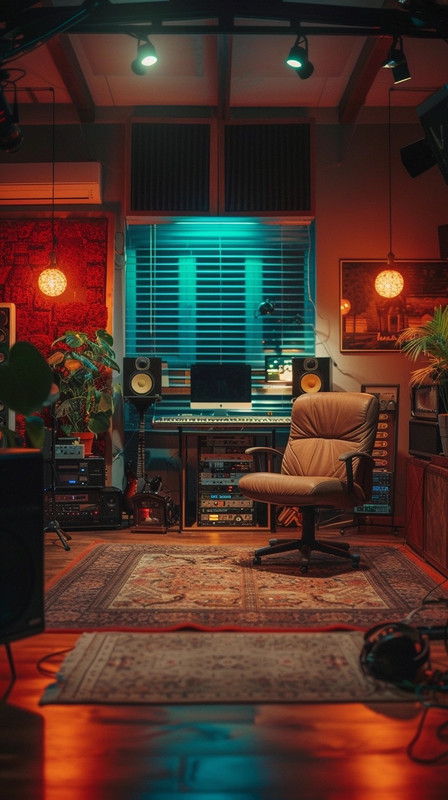

Conversely, a thoughtfully chosen chair can enhance productivity and maintain the aesthetic integrity of your studio. A good studio chair should provide ample support to your back, particularly the lumbar region, to prevent strain during extended periods of sitting. The battle against fatigue in the studio can often seem like an insurmountable challenge.
Certainly! The quest for the ultimate chair is not just about luxury; it's about finding a throne that caters to long hours of meticulous work, one that aligns with the rhythm of their craft.
These advancements have led to a new generation of studio chairs that not only offer unmatched comfort but also contribute to better posture and reduced strain on muscles and joints. This decision is not merely about comfort; it also encompasses health considerations and productivity implications.
Ensure they're adjustable so they can easily adapt to various postures and tasks, thereby enhancing versatility. In conclusion, selecting a music studio chair that exemplifies durability and build quality is essential for any professional working space.
Music production often involves dynamic body movements—reaching for that high note on a keyboard or pivoting swiftly from one piece of gear to another—and your chair must withstand constant use without losing its form or function. Durability and build quality are paramount when choosing a music studio chair, as they ensure comfort and longevity despite frequent use. Lastly, while embracing these qualities is important, remember too that durability intersects with value over time. Given that music production frequently demands hours of continuous sitting, an inexpensive chair might lead to physical strain over time.
Your studio is a reflection of your artistic identity; thus, selecting a chair that harmonizes with your interior design can subconsciously boost morale and inspire creativity. Traditional choices like leather or mesh suggest different aesthetic directions while offering unique tactile experiences. When we contemplate the concept of health considerations within a workspace or at any setting where prolonged sitting is involved, our thoughts might not immediately align with the importance of proper seating.
A subpar seat can lead to discomfort, distractions, and even health issues over time. Moreover, taking short but frequent breaks from sitting can help reset one’s posture and reduce the likelihood of fatigue.
Moreover, materials science has played its part by introducing breathable meshes and cushioning that conform more precisely to body contours while regulating temperature—eschewing the traditional foam padding which often traps heat. Lastly but importantly is sustainability; opting for chairs made from recycled materials or from companies committed to eco-friendly practices reflects an awareness beyond one's immediate surroundings—an ethos often inherent within the artistic community. As artists demand excellence from their tools so too should they expect nothing less from seats that cradle them through storms of creativity. The design of the chair should support your body's natural posture, reducing strain on your back, neck, and limbs. Ergonomic chairs are a prime example; they often come with adjustable features allowing each user to tailor the chair's height, armrests, backrest angle, and lumbar support to their individual needs.
One of the least probable places to look for a studio chair might be office supply stores offering clearance sales or going-out-of-business events. Each cushion whispers secrets of cloud-like serenity to weary backs bent over mixing consoles. Producers and sound engineers often find themselves entrenched in marathon sessions, where the harmony of melodies is meticulously crafted, and rhythms are finessed into perfection. debris Selecting the perfect chair for marathon recording sessions is an endeavor that oftentimes goes overlooked, yet it stands as one of the most critical elements in fostering a creative and productive environment.
Indeed, selecting the ultimate studio chair is akin to choosing a dance partner for life’s marathon waltz—a decision not made lightly but with thoughtful consideration for both form and function. However, I'll attempt this while trying to maintain some coherence in the text:"In realms of surreal unicorns, thrones embody mystical convergence where rainbows collide with earthworms. Firstly, let's dissect 'ergonomic.' An ergonomic chair is designed with human anatomy and physiology in mind. One exemplary model is the Herman Miller Aeron Chair.
Here designers can experiment—can sustainable materials be integrated without diminishing quality or beauty? Equally important is investing time into testing chairs before making a purchase. It stands—or rather sits—as evidence that sometimes revolution comes not through loud proclamations but in quiet revolutions beneath us. Secondly, let's talk about ergonomic support.


In conclusion, discerning producers must prioritize durability and build quality when selecting their central work tool—their chair—to foster an environment where creativity can flourish unimpeded by concerns over equipment reliability or comfort degradation over time. Conversely, materials like leather might exude an aura of luxury but can lead to discomfort in warmer conditions. Therefore, look for chairs with adjustable features such as lumbar support, height adjustment, and tilt functionality that conform to your body’s needs.
However, it's not uncommon to encounter durability issues or discomfort after prolonged use. Renowned for its ergonomic design, this chair boasts an innovative suspension system that distributes weight evenly, reducing pressure points.
Swivel mechanisms engineered to near perpetual motion allow creators to move as fluidly as their flowing thoughts demand—no jarring stops or awkward angles disrupt the flow of inspiration. Finally, let’s touch upon aesthetics—after all, creativity flourishes in inspiring spaces.
The material of the chair also matters greatly in terms of comfort and durability. Enter dynamic ergonomics: this innovative concept refers to chairs that adapt in real-time to the user's body. This increases efficiency as you reach for different pieces of equipment or instruments during your session. Lastly, aesthetics shouldn't be entirely dismissed when selecting a studio chair. Whether opting for industry staples like Herman Miller or Steelcase or going for more budget-friendly yet reliable options such as IKEA's offerings or gaming-oriented seats like those from Secretlab and DXRacer - there exists an array of choices designed to meet various needs while promising longevity.
A studio chair is not merely a place to rest; it represents a foundational element in a sanctuary where ideas flourish and concepts materialize. One often overlooked element in a studio setting is the chair you sit in for countless hours. Imagine a chair—an ordinary concept turned extraordinary by ergonomic wizardry—a throne for sound architects tirelessly weaving sonic tapestries through night's quiet hours. Creating a comfortable and ergonomic workspace is crucial for up-and-coming musicians who spend countless hours practicing and recording.
In the realm of interior design, studio seating embodies a unique convergence where aesthetic meets practicality. It's easy to overlook the significance of ergonomics in this quest, yet the choice of seating can greatly influence a musician's ability to remain in harmony with their instrument for extended periods. The innovative design is inspired by the dynamic posture of horseback riders; this ensures that your spine stays aligned and engaged throughout long sessions of work or creativity. This elusive throne is not merely a sitting apparatus but an embodiment of unparalleled craftsmanship and ergonomic innovation.
Thus concludes our capricious cataloging of esteemed studio chairs—champions chosen not through frivolous fancy but rigorous rendezvous between artist and instrument; where each note played is nurtured by unseen sentries made tangible only through absence when melody falters upon their departure—a testament to their silent symphony conducted below radar yet resonating beyond audible spectrums. Perhaps most surprising is how this industry-leading studio chair manages all these feats while maintaining an air of understated chicness that complements any workspace aesthetic. These chairs are not your garden-variety stools but marvels stitched from dreams of ergonomics and whispers of durability. In conclusion, acknowledging the profound impact that proper seating has on preventing fatigue and injury is paramount for maintaining overall well-being.

While aesthetic preferences evolve rapidly within creative fields, investing in timeless craftsmanship ensures that a top studio chair remains both functional and stylish across eras. Finally, while budget considerations may play second fiddle in this selection concerto, they cannot be ignored completely. They achieve this through several mechanisms such as self-adjusting lumbar supports, articulated backrests, and responsive seat pans. Ergonomics is paramount; after all, what good is a chair if it cannot provide comfort over extended periods? In conclusion, picking out an ultimate studio chair involves paying attention to details often dismissed by those unaware of their importance: lumbar alignment, seat depth precision, versatile armrests configuration, swiveling ease provided by silent casters - all crowned by personalized padding choices wrapped up in delightful design elements.
Breathable fabrics such as mesh can help keep you cool under pressure while leather or vinyl might be preferred for their ease of cleaning and sleek appearance. Your chair should complement the palette of your studio environment while also allowing personal flair to conduct its visual symphony. Secondly, swivel away from monotony by selecting a base with wheels or one that pirouettes effortlessly. Its armrests arc like crescendos cradling forearms weary from conducting symphonies of sliders and dials.
Whether for an artist's atelier, a musician's den, or a designer's workshop, each piece must serve dual purposes. home studio When seated upon such an exalted perch, distractions fade away like distant echoes; all that remains is you intertwined with your craft—unified in purposeful creation. The right chair can be pivotal in sustaining healthful practices while fostering an environment conducive to creative success—an investment worth making for any dedicated music professional looking to deliver their best work comfortably session after session. For artists, writers, designers, or any individual deeply engrossed in the creative process, an ideal studio chair serves as a steadfast companion through hours of introspection and imagination.
In small spaces, armless designs or those with flip-up arms offer flexibility; they tuck neatly under desks when not in use. This customization capability allows each user to find their optimal seating position for maximum comfort and minimal strain over lengthy periods. Spending hours on end in a studio requires a seat that offers unparalleled comfort and support to prevent fatigue and keep you focused on your craft. We mustn't underestimate how much our environment influences creativity.
The contours are sculpted to perfection, cradling the user in a supportive embrace that defies the conventional rigidity of average office furniture. Embarking upon this journey, one might envision typical office seating—stiff backrests and unyielding armrests—yet the pinnacle of studio thrones transcends such mundane expectations. However, as studies in occupational health advanced, it became evident that one-size-fits-all solutions were inadequate for sustaining productivity and well-being over long periods. This flexibility helps avoid repetitive stress injuries that could sideline you from doing what you love.
Firstly, consider the seat of discord: ergonomics. Components such as seat height, armrests, and tilt tension should be easily modifiable to suit individual preferences and body types. In contrast, extended periods of inactivity, especially in positions that strain particular muscle groups or impose unnatural postures, can lead to various health complications.
Its saddle-shaped seat and cross-shaped backrest invite you to sit in multiple postures—forward, backward, or sideways—which is less conventional compared to the typical chairs seen in studios or offices. Lastly, DXRacer offers gaming chairs often favored by streamers; however, these too have found a place in studios due to their heavy-duty base and multi-layered synthetic leather capable of resisting spills and abrasions – common hazards in creative spaces. Ultimately, aesthetics hold peculiar significance; after all, this chair sits at the heart of creativity's temple—the studio—and its design must inspire.
When contemplating the acquisition of a chair for music production pursuits, individuals are often confronted with a dichotomy: should one opt for budget-friendly seating solutions or invest in high-end furniture? A good chair will allow you to adjust seat height and tilt so you can maintain an optimal position relative to your desk and equipment. Investing in a high-quality model made from robust materials will save money in the long run as it won't require frequent replacements due to wear and tear. Spinal posture
Top DJs can earn significantly varying amounts per set, depending on their fame, demand, and the event's scale. For instance, world-renowned DJs like Calvin Harris, David Guetta, or Martin Garrix can command fees upwards of $100,000 to $500,000 for a single performance. In some exceptional cases, especially for exclusive events or festivals, these figures can soar even higher, reaching into the millions.
Joe Rogan uses the Human Touch Perfect Chair for relaxation and podcasting. Specifically, he has mentioned using the Human Touch PC-420 Classic Manual Plus Perfect Chair. This chair is known for its zero-gravity ergonomics, designed to reduce back pain and improve circulation, making it a comfortable choice for long podcast sessions or simply relaxing.
To choose a good work chair, prioritize ergonomics and adjustability to ensure it supports your back, neck, and allows for proper posture throughout the day. Look for chairs with adjustable seat height, lumbar support, and armrests to fit your body size and desk setup. Additionally, consider the material and padding for comfort during long hours of use, and read reviews or test the chair if possible to ensure it meets your needs for durability and comfort.
Ergonomic chairs are considered the best style of chairs for lower back pain. They are designed to support the natural curve of the spine, ensuring proper posture while sitting. Features such as adjustable lumbar support, seat depth, and armrests allow for a customized fit that can significantly reduce discomfort and strain on the lower back.